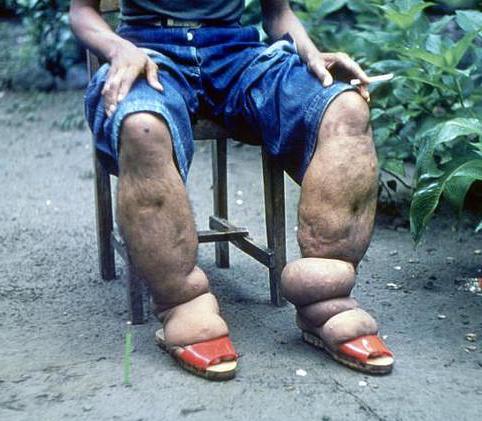At WiseGEEK, we're committed to delivering accurate, trustworthy information. Our expert-authored content is rigorously fact-checked and sourced from credible authorities. Discover how we uphold the highest standards in providing you with reliable knowledge.
What Are the Most Common Filariasis Symptoms?
Filariasis symptoms include skin rashes, arthritis, and a form of blindness. Abdominal pain is common as well. In many cases, a skin condition called elephantiasis also occurs. Fever, chills, and headache are usually the first symptoms experienced.
Also written as philariasis, filariasis is a type of parasitic disease that is classified as an infectious tropical disease. This condition occurs when a human host is invaded by filarial nematodes. There are nine species of the worms that are divided into three groups that cause their own filariasis symptoms.

Lymphatic filariasis occurs from an invasion of Wuchereria bancrofti, Brugia timori, or Brugia malayi worm species. These worms live in a human’s lymphatic system. Elephantiasis occurs in chronic instances of lymphatic filariasis. This symptom leads to a thickening of the skin and tissues underneath. The legs are generally affected, but the mucus membranes and ears can also be affected.

Subcutaneous filariasis symptoms occur when the African eye worm, guinea worm, Onchocerca volvulus, or Mansonella streptocerca species invade the subcutaneous layer of the skin. It is the form of invasion that can lead to blindness if left untreated too long. Common symptoms of this form are rashes and other skin related conditions. The Onchocerca volvulus species causes onchocerciasis, or river blindness.

The third group, serious cavity filariasis, occurs when the Mansonella ozzardi or Mansonella perstans species occupy the serous cavity located in the abdomen. The most common filariasis symptoms of this form include abdominal pain. In some cases, the abdominal pain can accompany a subcutaneous invasion, which causes a bit of confusion.
When filariasis symptoms start occurring, a definitive diagnosis is achieved by a finger prick test. The small amount of blood is used with a film smear. Testing is done at crucial times when the presence of filarisis worms is highly detectable, which is based on the type of insect that transmitted the worms.
Many worm species are transmitted to humans by contact with a biting insect, such as a mosquito or deer fly. Some species do not rely on blood for transport. To test for these species, a skin snip is used, which does not rely on time restrictions.
After diagnosis, treatment is necessary to kill the worms. Anti-parasitic medications will kill the parasites and larvae. Dosing starts low and is increased gradually to prevent an excessive amount of parasites dying all at once.

Side effects of the medication and parasite death include nausea, vomiting, weakness, and muscle aches. Some patients may also experience dizziness, asthma, lethargy, and headache. Elephantiasis cannot be reversed, but surgery can relieve fluid accumulation that may occur.
AS FEATURED ON:
AS FEATURED ON:

















Discuss this Article
Post your comments